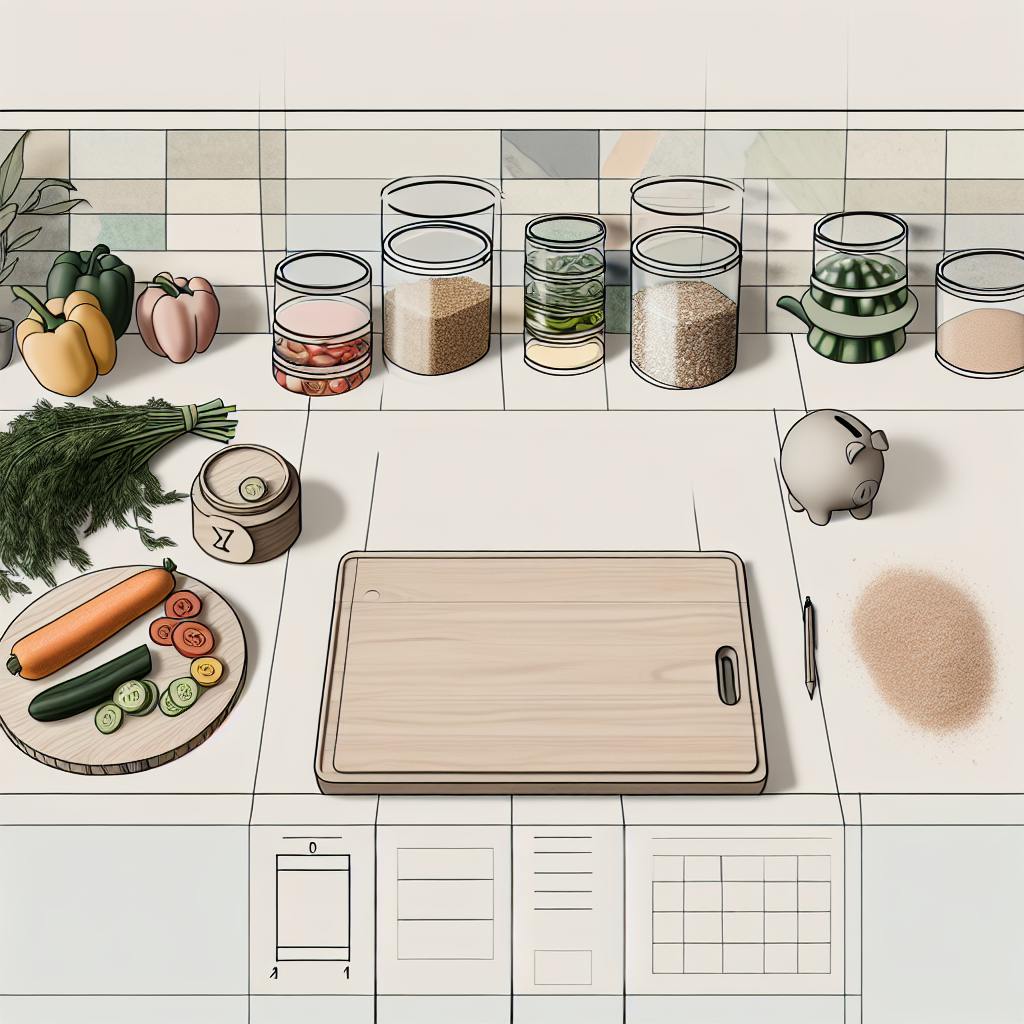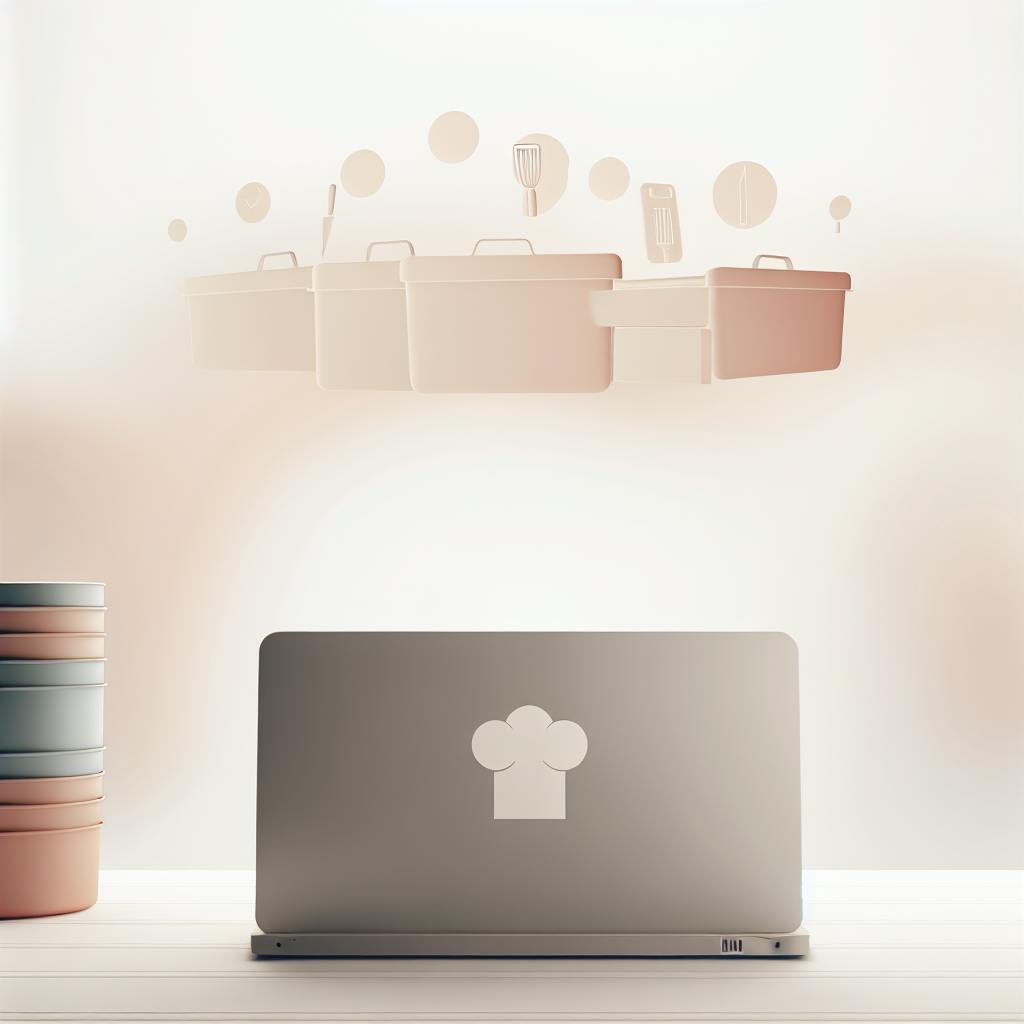For meal prep services, having a streamlined system to manage recipes is crucial for efficiency.
By implementing recipe management software with key features like cloud storage, scaling tools, menu planning, purchasing integrations, and analytics, services can boost accuracy and productivity across all locations.
In this post, we'll explore the essentials of recipe software - from accessing recipes on any device to planning compliant menus and getting data-backed insights - to help services enhance their operations.
Introduction to Recipe Management Software
Recipe management software provides an efficient way for meal prep services and restaurants to organize recipes, plan production, and track inventory. By centralizing recipe data and connecting it with ordering and inventory systems, recipe management platforms aim to boost productivity in commercial kitchens.
This article explores key features small business owners should evaluate when searching for the right recipe software to meet the needs of their operation. We'll cover how the software can transform workflow efficiency as well as what to look for in the ideal user interface.
Understanding the Impact of Recipe Management Software
Recipe management systems offer a range of potential benefits:
- Enhanced organization - Store all recipes, ingredients, and instructions in one secure, cloud-based location accessible to authorized users from any device.
- Improved efficiency - Automate scaling of ingredient amounts based on production volumes. Reduce time spent on recipe management administrative tasks.
- Increased accuracy - Standardize recipes to minimize errors. Update recipes globally across the system.
- Better reporting - Gain insight into most popular dishes, profitable menu items, ingredient costs, and other key production metrics.
By centralizing and digitizing recipes, staff save time searching for resources while minimizing mistakes. This allows the team to focus their efforts on food preparation and customer service.
Navigating the Features of Recipe Software for Restaurants
An intuitive interface and role-based access makes it simple for staff to learn and use a recipe platform daily:
- Easy searching - Quickly find recipes by name, ingredient, chef, category, cuisine, or custom tags.
- Customizable fields - Tailor recipe, inventory, and production templates to match existing systems.
- Structured workflows - Guide users through scaling recipes, building menus, placing orders, and more.
- Responsive support - Get timely answers to platform questions so the technology never hinders operations.
Prioritizing ease-of-use, tailored configuration, and robust training helps ensure maximum adoption across the organization. This empowers staff to fully utilize the platform to enhance culinary operations.
Is there an app to organize my recipes?
Recipe management software provides an efficient way for meal prep services to organize recipes and streamline kitchen operations. Key benefits include:
Easy Recipe Organization
- Upload or import recipes from other apps and documents
- Categorize by course, cuisine type, dietary needs, etc.
- Add recipe notes and customize as needed
- Access recipes from any device
Improved Kitchen Workflows
- Print recipes with ingredients list for prep
- Sync recipes across devices in real-time
- Track recipe changes and nutrition info
- Build menus and schedule production
Enhanced Order Accuracy
- Update recipes and instantly push changes
- Ensure version control and consistency
- Reduce order errors caused by outdated recipe cards
Cloud-Based Access
- Access recipes from any internet-connected device
- Store unlimited recipes securely in the cloud
- Backup recipes to prevent losing versions
- Share recipes with staff as needed
In summary, using recipe management software helps meal prep businesses boost productivity, enhance order accuracy, and securely organize recipes for their kitchen teams. This enables them to deliver consistent, high-quality meals tailored to customer preferences and diet needs.
What is a recipe management system?
A recipe management system is software that helps meal prep services and other food businesses efficiently organize recipes, plan production, and track inventory. Key features of a robust recipe management system include:
- Centralized recipe database to store recipes with ingredients, instructions, images, and more
- Recipe scaling to adjust ingredient quantities based on production needs
- Nutritional analysis to calculate macros and allergens
- Inventory tracking to manage stock levels and place orders
- Menu planning tools to select recipes and auto-generate shopping lists
- Integrations with kitchen appliances to simplify recipe sending and guide cooks through each step
With an effective recipe management software, companies can simplify recipe handling, standardize production, minimize waste, and ensure consistency across all locations. This enables food businesses to scale efficiently while controlling costs.
Meal prep services in particular benefit from automating recipe management. A reliable system helps centralize recipe data, plan weekly menus, track inventory ingredients, and guide kitchen staff through each meal's prep - improving speed, accuracy, and accountability. As orders come in, the software can also auto-print ingredient labels and packing slips tailored to each customer's selections.
By removing the guesswork around recipes, inventory, and production, a recipe management platform like Eat Fresh Tech helps meal prep services focus on food quality and customer satisfaction. The system evolves alongside your business needs, providing the insights and tools to make your kitchen operation run smoothly.
What is recipe management in MES?
Recipe management software integrated with an MES (manufacturing execution system) provides automated control over recipes used on production equipment. This ensures:
- Accuracy - The correct recipe is always loaded onto the right equipment for the product being made. Human error is eliminated.
- Traceability - Any changes made to recipes are tracked, supporting quality control and regulatory compliance.
- Efficiency - Recipes can be rapidly distributed to multiple pieces of connected equipment with one click. No manual data entry needed.
For meal prep services, an integrated RMS/MES solution offers key benefits:
- Consistency - Standardized recipes are used by all staff, leading to uniform quality.
- Organization - Recipes, ingredients, and nutrition info are digitized in one central database. Easy to find, update, and sync recipes across the business.
- Adaptability - Adjust recipes on the fly as inventory levels change. Menu planning and costing also improved.
With automated recipe management in place, kitchen operations gain accuracy, traceability, and flexibility. Staff can focus less on manual paperwork and more on food preparation and customer service.
How do you store recipes digitally?
There are a few easy ways to store your recipes digitally for convenient access in your meal prep business's kitchen operations:
Use a scanner or phone app
- You can use a document scanner or a phone app that can scan pages from your cookbooks and convert them into digital text. There are several handy apps available for both Android and iOS devices that can quickly scan paper recipes into digital formats.
- Once scanned, these apps allow you to save the recipes as image files or searchable PDFs that you can easily store in designated digital folders or recipe management software.
- Scanning apps provide an efficient way to quickly build up a digital database of all your paper recipes.
Take photos
- Simply taking photos of recipes from cookbooks or handwritten recipe cards can also create digital copies.
- You can set up a designated station with good lighting and a tripod to cleanly capture recipe pages.
- The photos can then be uploaded to cloud storage or your recipe management software for anytime access.
Use recipe management software
- Rather than relying solely on scanners or phone cameras, recipe management software purpose-built for commercial kitchens offers robust tools to not only digitize recipes, but also organize, edit, cost, and track them.
- These solutions provide structured databases to neatly store, categorize, and sync recipes across devices. Staff can access recipes from any kitchen workstation for accuracy and efficiency.
- Advanced options also allow scaling ingredient amounts, building menus, and integrating with inventory and ordering systems for streamlined kitchen operations.
In summary, investing in dedicated recipe management software provides the most efficient system for handling recipes digitally with tools tailored to commercial needs. But scanners and phone cameras can also quickly create digital copies accessible across devices.
Centralized Recipe Database for Meal Prep Services
Consolidating recipes in a searchable database with version control streamlines accessing, editing, and distributing current recipes across all kitchen locations. This allows cooks to easily find recipes and ensure they are using the most up-to-date versions.
Optimizing Recipe Access with Cloud Storage
Storing recipes in the cloud makes them accessible from any location. Features like smart search and custom tags make finding specific recipes simple. For example, cooks could:
- Search recipes by ingredients
- Filter by dietary needs like gluten-free or vegan
- Tag recipes by category like appetizers or desserts
They can also sort recipes alphabetically or by popularity to quickly locate favorites. These tools help cooks access the right recipes faster so they can work more efficiently.
Additionally, cloud-based access means any updates made to recipes automatically sync across locations. So when recipes change, the new versions are instantly available systemwide.
Consistency Across Locations with a Recipe Management App
With recipes stored centrally in the cloud, all locations access the same set. This ensures consistency in the recipes used across kitchens.
For multi-location meal prep businesses, a recipe management app guarantees:
- Standardized recipes used company-wide
- Identical dishes prepared at all kitchens
- No variation between locations
It also simplifies training. Since everyone uses the same recipes, new hires learn according to standardized company methods.
Centralized recipes prevent situations where some locations use outdated versions. Cloud access makes sure the entire company stays up to date.
Scaling and Costing for Efficiency and Accuracy
Built-in scaling tools connect recipes to inventory and ordering so meal prep businesses can plan production to minimize waste and meet demand.
Recipe Costing for Food and Drink Establishments
Precise ingredient amounts per serving make it easy to calculate exact recipe costs for menu pricing. Recipe management software allows restaurants and meal prep services to:
- Accurately calculate recipe costs based on ingredient pricing
- Adjust pricing as ingredient costs fluctuate
- Determine ideal profit margins for each menu item
With detailed recipe costing, kitchen operations can set competitive menu prices while maximizing profits.
Dynamic Recipe Scaling for Variable Meal Prep Demands
Easily adjust recipe yields higher or lower to match daily production needs and prevent over-prepping. Recipe management software enables:
- Scaling recipe batch sizes up or down
- Connecting scaling to inventory management
- Planning exact meal production quantities
- Reducing food and drink waste
Dynamic scaling paired with projected order volume results in greater efficiency and accuracy. Businesses only prep what they need, streamlining kitchen operations.
Menu Planning: A Core Feature of Recipe Software
Robust menu planning features allow meal prep services to organize weekly recipes and print prep sheets to keep kitchen operations running smoothly.
Crafting Weekly Menus with Precision
Recipe management software gives meal prep businesses the tools to efficiently plan menus and schedule production. Key benefits include:
- Build reusable recipe catalogs to select dishes from week-to-week
- Create rotating weekly menus with drag-and-drop ease
- Designate prep recipes to specific days of the week
- Set recipe targets based on sales history and projections
- Adjust menus and quantities using up-to-date order data
Careful menu planning ensures you have just enough ingredients on hand without overprepping dishes or leaving customers with limited choices.
Efficient Prep Sheets for Cooking Operations
In addition to menus, recipe software generates handy prep sheets for upcoming production days. Prep sheets list:
- All recipes scheduled for the day
- Ingredient amounts needed per recipe
- Step-by-step cooking directions
- Labeling specifications per meal
With detailed prep sheets, kitchen staff can work efficiently as a team to cook recipes to perfection and accurately package each order. This prevents wasting ingredients from errors and frees up time for quality control checks.
Robust recipe management platforms give meal services unmatched precision and control over weekly menus and streamlined kitchen workflows. With less effort spent on planning, prep cooks can fully dedicate their time to safely preparing delicious, fresh meals customers love.
Integrating Purchasing with Recipe Management Software
Integrations with food purveyors streamline ordering and synchronize purchase orders with recipe requirements for simplified procurement.
Automated Ordering for Streamlined Kitchen Operations
Automatically generating purchase orders based on upcoming production plans prevents over-ordering ingredients and streamlines kitchen operations. Features like consolidated order forms that pull recipe requirements from the production schedule simplify procurement.
Benefits include:
- Preventing last-minute ingredient shortages that delay meal prep
- Eliminating manual oversight of order quantities
- Reducing food waste from spoilage of over-ordered items
By connecting with food suppliers through the software, meal prep services can have orders created, sent, and tracked automatically based on real-time inventory and upcoming recipe needs.
Real-Time Inventory Management for Recipe Accuracy
Syncing ordered ingredients with current stock levels provides real-time inventory visibility across locations. This ensures that recipes always have the right amounts of each component in stock.
Key features that enable this include:
- Automatic updates of inventory levels when purchase orders are received
- Warnings when measured ingredients for a recipe exceed stock on-hand
- Moving ingredients from one location to another to meet production needs
With purchaser orders and inventory tied together through the system, kitchen operations can ensure accuracy in recipes based on what's in stock. This prevents shortages mid-production and keeps customers happy with consistent meals.
Leveraging Reporting and Analytics in Recipe Software
Reporting and analytics features in recipe management software provide meal prep businesses with valuable insights to inform data-driven decisions. With detailed visibility into key metrics around recipes, menu items, and operations, services can optimize everything from ingredient costs to nutritionals.
Analyzing Sales and Costs for Recipe Optimization
Careful analysis of bestselling and most profitable menu items enables strategic decisions around production volumes and pricing:
- Review sales reports showing top-selling recipes and menu items over custom time ranges. Identify consistent customer favorites to prioritize cooking and potential opportunities to showcase underperforming dishes.
- Analyze recipe costs and compare to selling prices to calculate and optimize profit margins. Reduce waste by right-sizing batch volumes for menu items based on their popularity.
- Filter reports by categories like dietary preferences or restrictions. Discover successful options to expand those offerings if needed.
- Enable dynamic pricing rules based on real-time supply and demand. For example, increase prices on popular last-minute orders to better cover on-demand production costs.
Nutritional Analysis for Compliant Food and Drink Menus
Detailed visibility into nutritionals at the ingredient level is crucial for regulatory compliance and marketing:
- Automatically calculate macro- and micronutrients for every recipe variation. Confidently demonstrate compliance with guidelines for health claims or programs like Weight Watchers.
- Filter recipes by nutrients like calories, fat, carbs, and protein. Identify lower-calorie options to create more diet-friendly menus.
- Compare recipes side-by-side to substitute ingredients for improved nutritionals. For example, reduce saturated fats or sodium without sacrificing taste.
- Display key nutrition facts directly on menus and packaging. Promote the healthy aspects of meals to attract customers with special diets or fitness goals.
With data-driven insights from their recipe software, meal services can make smarter decisions to reduce costs, create optimal menus, and market their offerings more effectively. The result is higher customer satisfaction, increased order values, and reduced waste.
Conclusion: Choosing the Best Recipe Management Software
The right recipe management software is essential for meal prep businesses looking to boost efficiency, accuracy, and growth across their kitchen operations. When evaluating options, keep these key features in mind:
Centralized Access
- Cloud-based software enables access to recipes and kitchen data from any device
- Staff can view recipes, instructions, and prep lists in real time
- Reduces errors caused by outdated spreadsheets or paper systems
Easy Scaling
- Unlimited recipes, ingredients, and menu items
- Built-in tools for batch editing recipes
- Options to clone recipes then tweak as needed
- Supports adding new locations as your business grows
Robust Planning Features
- Drag-and-drop recipe planning calendar
- Adjust recipes, portions, and ingredients for each meal
- Menu analysis shows costs, nutrition, allergens, and more
Data Insights
- Track most popular recipes and successful menus
- Identify least profitable or labor-intensive meals
- Guide menu planning and inventory decisions
The right software centralizes access, connects teams, and provides data to streamline planning - enabling higher efficiency, fewer errors, and smarter decisions as your business expands.


